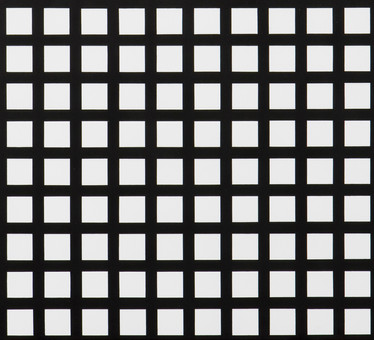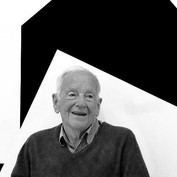François Morellet

Cholet, France, 1926 —
Cholet, France, 2016
One of the founders of the Groupe de Recherche d’Art Visuel (GRAV), François Morellet pursued an art totally foreign to any expressionism, giving rise to a work that combines the rigor of numbers and algorithms with the graceful poetics of chance.
Starting his work with geometric abstraction in the 50s, Morellet produced works governed by a system of composition established a priori, free from the maximum of subjective interferences. Thus, works like 16 carrés 96 triangles (1952) were born, in which the alternation between black and white triangles and squares obeys a rigorous serialization, and also Violet, bleu, vert, jaune, orange, rouge (1953), whose repetition of the six colors present in the painting it operates under a principle of progressive unfolding. From 1958 on, Morellet adopted the use of randomness, further restricting the possible range of subjective choices open to the artist. Thus, in a work like Répartition aléatoire de 40 000 carres selon les chiffres pairs et impairs du bottin téléphonique (1961), the positions of the blue and red on the plane are determined randomly from the numbers in the Paris phone book, while that in 10 lignes au hasard (1971) Morellet makes use of the digits of the number π (pi) in order to determine the angulation of the lines that cross the pictorial plane.
Morellet’s experiments with chance gain even more complexity and unpredictability in his installations. Assembled with industrial materials, especially neon light, these installations integrate movement and time. In them, the spectator becomes a decisive agent in the constitution of the works when called upon to activate them, thus playing a role of symmetrical importance to that of the artist himself. An example of the importance of the participant, Reflets dans l’eau déformés par le spectateur (1964) is a web of neon lamps whose light is reflected on a water tank. This reflection can be disturbed and distorted by the viewer, invited to manipulate a lever that makes the water ripple and generate countless other shapes from that first plot. Already in 2 frames 45 ° -135 ° of neon interference (1972), the viewer is surrounded by three walls where red neon lamps are affixed. The luminosity of the work, its order and variations are released from the way in which the viewer activates the lamps. In both cases, it cannot be said that there is only one artistic work, as the installations are characterized by their virtuality, by the countless number of ephemeral works they contain, ready to appear and disappear at a glance under the viewer’s gesture, now also creator of the work of art.
Throughout his career, Morellet can also install neon lights on the facade of buildings, benefit from digital computing to further explore the digits of the number π, among other experiments. In all of these cases, Morellet’s work suggests a renewed understanding of artistic creation and even creativity. They cease to be an attribute restricted to the artist, surpassing it by implying the force of chance contained in the eventual and in the participatory, making art an open and collective experience.
VRP
